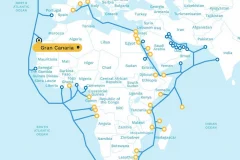This article was contributed to TechCabal by Maria Adediran.
The fact that you exist is not news…
Occasionally, a crisis or controversy in the African tech ecosystem ignites debates among founders and influencers about the merits of local versus international media coverage. While it’s undeniable that sensational headlines can spread like wildfire, accusing the local tech media of a sole focus on the negative is neither fair nor accurate.
At Wimbart, after eight years in the industry, I’ve come to understand a fundamental truth that also happens to be Wimbart CEO’s Twitter cover story: The fact that you exist is not news. Whilst raising over a million seed in funds could guarantee you coverage, whether you’ve launched a new product or expanded, journalists will always ask, “So what?” What’s the impact, the innovation, the human story?
The African tech market is brimming with startups eager to share their narrative. At Wimbart alone, where we represent a modest fraction of African-focused companies, we often find ourselves amongst at least three different teams pitching to the same journalist in any given week. It’s important to recognise that journalists’ inboxes are inundated with up to 50, sometimes hundreds of pitches, on any given day. Recognising their hard work is crucial—they are the storytellers who have elevated our narratives, making international media platforms not only notice but also hire local teams to push the narrative further. When I began working in PR for African tech, capturing the attention of international media was a formidable challenge—it was H-A-R-D. We owe much to local publications that have tirelessly championed our stories; they deserve our gratitude, or “flowers,” if you will.
Pitching a story that will resonate and secure media coverage is an intricate art. For those with in-house communications teams or a PR agency like Wimbart, there’s support to sculpt the narrative. Yet, we are aware that not all, especially early-stage startups, have these resources. If your pitches happen to be met with a rate card, it‘s an indicator that what is being pitched is perceived more as promotional than editorial content. There lies the distinction between what is known as “earned media” and “paid media”. In layman’s terms, earned media is akin to a badge of honour, granted for its intrinsic worthiness, whereas paid media is a lot more straightforward; it’s coverage that you pay to secure—zero thought required. Each serves a purpose but they are not interchangeable.
So, you’re set on securing earned media coverage without resorting to financial outlay? Excellent decision. Below are some actionable steps that can elevate your story from just another pitch that ends up unread to headline-worthy news:
Research publications and journalists
Finding the right journalist for a media outlet to share your startup’s story should mirror the process of choosing the perfect business partner or founding team. It involves aligning your startup’s mission with the outlet’s editorial focus where possible, ensuring there is mutual interest and goals. This due diligence involves thorough research into their past work and identifying the journalists within a specific publication who champion themes that resonate with your venture. Whether it’s your company’s innovative approach to sustainability, significant funding achievements, or the founder’s unique profile, finding that match means you’re ready to pitch.
Pitching to the right person transcends mere coverage; it becomes an opportunity to weave your story into their ongoing narrative. It’s about creating a partnership where your startup’s achievement and aspirations complement their storytelling, ensuring that your narrative gets shared and truly resonates with their audience, creating a meaningful impact.
Attention-Grabbing Subject Email
Your email’s subject line is the gateway to capturing a journalist’s attention, so make every word count. Imagine you’re crafting the editorial for tomorrow’s newspaper, it should be compelling enough to make anyone pause and take notice. Take inspiration from the impactful stories you see on major platforms titles like “How [innovation/company] is changing [industry]” are not just headlines, they are calls to curiosity. Use this approach to mirror each publication’s storytelling style in your email subjects. This not only piques interest but also shows you’ve done your homework and understand what resonates with their readership.
Keep it punchy and to the point
Keep your pitch concise and riveting. As highlighted above, journalists sift through a mountain of pitches daily, so you need to make yours stand out by hitting the key point right from the start, much like you’d share a piece of irresistible gossip with a friend. Highlight the most compelling aspect of your story immediately to grab their attention otherwise you risk losing it before the second paragraph—this could include striking data, a customer story, etc. If there’s depth to add, consider bullet points or a summary after your email signature. Alternatively, you could keep it in reserve for a follow-up, which is often required. Reading lengthy pitches can be daunting, but this strategy respects journalists’ time and piques their curiosity, significantly enhancing the chances of your story being featured. It’s about striking the perfect balance: being informative yet engaging, ensuring your message is not just another in the huge pile but a must-read.
Build a relationship before pitching
Fun fact: My path to landing my first big feature was paved not just by an intriguing story, but more so by the relationship I had nurtured with the journalist well ahead of the time I needed to pitch my client’s news. It’s crucial to start building these connections early, long before the urgency to disseminate your news arises. This can be done by demonstrating a sincere interest in their work, engaging in meaningful conversations, and extending your assistance, such as connecting them with a speaker, without immediately anticipating a return; it can remarkably shift your stance from that of an outsider to a respected collaborator. I’ve found that the most fruitful relationships are those where communication can be as simple as sending bullet points over WhatsApp. Yet, reaching this level of informality and trust with journalists requires an investment of time and genuine interaction, moving you from just another contact in their inbox to a trusted and familiar figure.
As we’ve established, the art of pitching is nuanced, requiring more than just presenting facts—just because a publication is considered “local” or regionalised, it doesn’t mean you shouldn’t practice the art of pitching. Truthfully speaking, you could tick all of the right boxes with your pitch and due to timing or resources, it doesn’t get picked up. But if your pitch is compelling and memorable enough, the journalist will come back to you at the appropriate time. Journalists seek stories that captivate their audience and bring significant attention to their platforms, therefore pitching must be strategic. By following these tips, founders can not only refine their failed approach but also build respectable, productive relationships with African tech media. This foundational work is crucial for when it’s time to scale up efforts and introduce a PR expert *cough, Wimbart* to the fold. Let’s turn your innovation into news that matters.





















